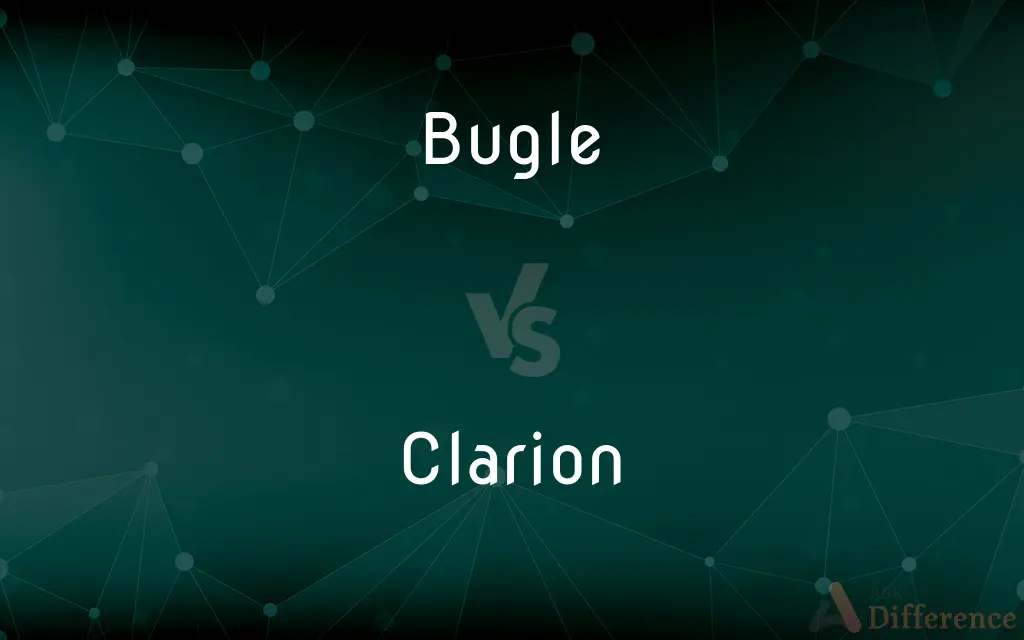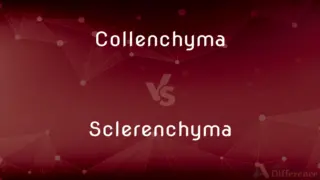Bugle vs. Clarion — What's the Difference?
By Tayyaba Rehman & Urooj Arif — Updated on May 2, 2024
The bugle is a simple brass instrument without valves, used for military signals, while the clarion, a medieval trumpet, delivers clear, shrill tones.

Difference Between Bugle and Clarion
Table of Contents
ADVERTISEMENT
Key Differences
The bugle, made from brass, is known for its valveless design, producing a limited range of notes via the player's embouchure. On the other hand, the clarion, historically a type of trumpet, was used for high, clear notes and heraldic purposes.
Used extensively in military contexts, the bugle plays a crucial role in ceremonies and commands. The clarion, whereas, was often associated with medieval and Renaissance courts as a signal instrument.
The bugle’s design is straightforward, typically consisting of a coiled tube with a flared bell. Conversely, clarions were straighter and characterized by a brighter tone, designed for clarity over distance.
In terms of playability, the bugle is relatively easy to learn due to its lack of valves, focusing purely on embouchure to change pitches. The clarion, on the other hand, demands more precise control for its high-pitched sounds.
Today, the bugle is still used in modern military and scouting events, symbolizing tradition and order. The clarion, however, is largely obsolete, primarily found in historical music ensembles and reenactments.
ADVERTISEMENT
Comparison Chart
Structure
Valveless, coiled brass
Straight, often with loop
Historical Use
Military signaling
Court and heraldic use
Tone
Limited pitch range
High, clear pitch
Difficulty of Play
Easier, no valves
Requires precise control
Modern Usage
Military, ceremonial
Mostly historical
Compare with Definitions
Bugle
An instrument without valves, relying on embouchure.
Learning the bugle involves mastering the use of lip tension.
Clarion
Produces high-pitched notes effectively.
The musician’s skill with the clarion impressed the audience.
Bugle
Symbolic in scouting organizations.
The scout leader taught the young members how to play the bugle.
Clarion
A medieval trumpet known for clear, shrill sounds.
The clarion call heralded the arrival of the king.
Bugle
A brass wind instrument used for military signals.
The soldier played a somber tune on the bugle at dusk.
Clarion
Now mostly found in historical music contexts.
He specialized in playing the clarion at medieval fairs.
Bugle
Used in traditional military settings.
Every morning, the camp was awakened by the call of a bugle.
Clarion
Historically used in court and heraldic settings.
Clarions were once a staple in royal processions.
Bugle
Plays a key role in ceremonial contexts.
The bugle call during the ceremony added a poignant touch.
Clarion
Demands high control and skill from the player.
Playing the clarion requires more than just practice; it needs precision.
Bugle
The bugle is one of the simplest brass instruments, normally having no valves or other pitch-altering devices. All pitch control is done by varying the player's embouchure.
Clarion
A shrill narrow-tubed war trumpet.
Bugle
(Music) A brass instrument somewhat shorter than a trumpet and lacking keys or valves.
Clarion
Loud and clear
Clarion trumpeters
Bugle
The loud resonant call of an animal, especially a male elk during rutting season.
Clarion
Loud and clear
A clarion call to resistance.
Bugle
A tubular glass or plastic bead that is used to trim clothing.
Clarion
A medieval trumpet with a shrill clear tone.
Bugle
Any of several creeping Old World herbs of the genus Ajuga in the mint family, having opposite leaves, square stems, and terminal spikes of purplish to white flowers. Also called bugleweed.
Clarion
The sound of this instrument or a sound resembling it.
Bugle
(Music) To sound a bugle.
Clarion
A medieval brass instrument chiefly used as a battle signal; related to the trumpet, it had a narrow, straight pipe and a high-pitched, piercing sound.
The clarion’s call to action has been heard.
Bugle
To produce a loud resonant call, as of a rutting male elk.
Clarion
(by extension)
Bugle
A horn used by hunters.
Clarion
(poetic) The sound of a clarion (sense 1), or any sound resembling the loud, high-pitched note of a clarion.
Bugle
A simple brass instrument consisting of a horn with no valves, playing only pitches in its harmonic series
Clarion
(music) An organ stop consisting of pipes with reeds giving a high-pitched note like that of a clarion (sense 1).
Bugle
Anything shaped like a bugle, round or conical and having a bell on one end.
Clarion
(heraldic charge) A charge thought to represent a type of wind instrument, a keyboard instrument like a spinet, or perhaps a rest used by a knight to support a lance during jousting.
Bugle
The sound of something that bugles.
The bugle of an elk
Clarion
Of a sound, a voice, a message, etc.: brilliantly clear.
Her clarion top notes
Bugle
A sort of wild ox; a buffalo.
Clarion
(transitive)
Bugle
A tubular glass or plastic bead sewn onto clothes as a decorative trim
Clarion
To announce or herald (something) using a clarion (noun sense 1).
Bugle
A plant in the family Lamiaceae grown as a ground cover Ajuga reptans, and other plants in the genus Ajuga.
Clarion
Of a thing: to cause (a place) to echo with a sound like that of a clarion.
Bugle
To announce, sing, or cry in the manner of a musical bugle.
Clarion
(intransitive) To sound a clarion; also, to make a high-pitched, piercing sound like that of a clarion.
Bugle
(obsolete) jet-black
Clarion
A kind of trumpet, whose note is clear and shrill.
He sounds his imperial clarion along the whole line of battle.
Bugle
A sort of wild ox; a buffalo.
Clarion
A medieval brass instrument with a clear shrill tone
Bugle
A horn used by hunters.
Clarion
Blow the clarion
Bugle
A copper instrument of the horn quality of tone, shorter and more conical that the trumpet, sometimes keyed; formerly much used in military bands, very rarely in the orchestra; now superseded by the cornet; - called also the Kent bugle.
Clarion
Proclaim on, or as if on, a clarion
Bugle
An elongated glass bead, of various colors, though commonly black.
Clarion
Loud and clear;
A clarion call
Bugle
A plant of the genus Ajuga of the Mint family, a native of the Old World.
Bugle
Jet black.
Bugle
A brass instrument without valves; used for military calls and fanfares
Bugle
Any of various low-growing annual or perennial evergreen herbs native to Eurasia; used for ground cover
Bugle
A tubular glass or plastic bead sewn onto clothing for decoration
Bugle
Play on a bugle
Common Curiosities
What is a clarion?
A clarion refers to a type of high-pitched trumpet used historically in courts and for heraldic purposes.
Is the clarion still used today?
The clarion is mostly obsolete, primarily used in historical reenactments and music ensembles.
What is a bugle?
A bugle is a simple, valveless brass instrument used mainly for military signals.
Where is the bugle commonly used today?
The bugle is commonly used in military settings and scouting ceremonies.
Can the bugle play different pitches?
Yes, although limited, different pitches on a bugle are achieved by altering embouchure.
What are the structures of bugles and clarions?
Bugles and clarions are both brass instruments that share many similarities in their structure. They both consist of a long metal tube that is coiled into a compact shape, with a flared bell at one end and a mouthpiece at the other.
Was the clarion used in battles?
The clarion was primarily used for courtly and ceremonial purposes, not typically in battle.
How does the sound of a bugle differ from a clarion?
The bugle produces a limited range of mellow tones, whereas the clarion delivers clearer, shriller notes.
What skills are required to play a bugle?
Playing the bugle requires mastering embouchure, or lip tension, as it has no valves.
What skills are required to play a clarion?
Playing the clarion demands precise breath control and embouchure to achieve its high notes.
Share Your Discovery

Previous Comparison
Garnish vs. Garner
Next Comparison
Collenchyma vs. SclerenchymaAuthor Spotlight
Written by
Tayyaba RehmanTayyaba Rehman is a distinguished writer, currently serving as a primary contributor to askdifference.com. As a researcher in semantics and etymology, Tayyaba's passion for the complexity of languages and their distinctions has found a perfect home on the platform. Tayyaba delves into the intricacies of language, distinguishing between commonly confused words and phrases, thereby providing clarity for readers worldwide.
Co-written by
Urooj ArifUrooj is a skilled content writer at Ask Difference, known for her exceptional ability to simplify complex topics into engaging and informative content. With a passion for research and a flair for clear, concise writing, she consistently delivers articles that resonate with our diverse audience.
















































